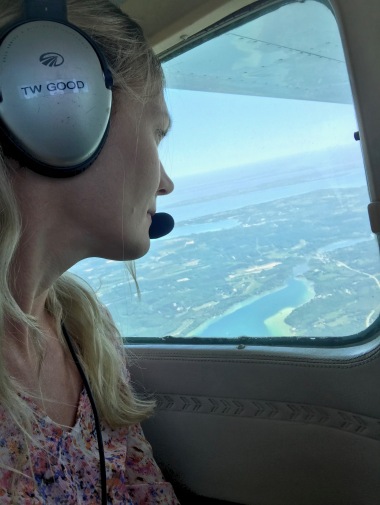Andrea VanderWoude is a remote sensing specialist — that means she’s looking at things from far away. Whether she’s studying harmful algal blooms or rip currents, her job is to pull information out of pictures taken from airplanes or satellites. What makes her extra good at it? She’s got an artistic streak! Read on to learn more.
How would you describe your job?
As a remote sensor, I use satellites and airborne cameras to monitor the Great Lakes – specifically harmful algal blooms, rip currents and submerged aquatic vegetation. I am an oceanographer working on the Great Lakes and most people wonder how that is possible. The lakes are so large they behave similarly to the ocean. I coordinate flights out of the Ann Arbor, Michigan airport with a contracted pilot that we work with and we put a small hyperspectral camera in the back of the airplane to take photos of the lakes.
Hyperspectral means that there are many discrete [color] bands or channels that are used (these colors are more detailed than the human eye can see). These channels can be used to map harmful algal blooms, which absorb, scatter and reflect light in a specific way. The hyperspectral camera is also able to fly underneath the clouds where passive sensors on satellites are unable to see. My day is spent programming, writing algorithms to process the images and looking at beautiful imagery. It is a wonderful blend of science and art!
What is the most interesting thing you’ve accomplished in your job?
Every year we fly over the Sleeping Bear Dunes National Lakeshore to monitor submerged aquatic vegetation and specifically for cladophora. As a northern Michigander growing up in that area, it is always amazing to see that area from the sky and to dream about hiking the Manitou Islands again. I also enjoy contributing to aiding the mapping of submerged aquatic vegetation in an area that is personally important to me.
What do you feel is the most significant challenge in your field today?
The most significant challenge I think is keeping up with the changing technology at the speed it is developing at this time. We are working on getting our new hyperspectral camera on an unmanned aerial system (UAS) for rapid response and I am really interested in using UAS’s for frequent monitoring of rip current troughs in the Great Lakes.
Where do you find inspiration? Where do your ideas come from in your research or other endeavors in your job?
I found my inspiration from growing up on the lakes and my parents always made a point of being on the water during all times of the year, either on Lake Michigan or Lake Superior. I have always felt connected to the water and jump in the lake during every month of the year, as a surfer on the Great Lakes. My ideas come from the public and what public needs could be supported. While living on the west side of Michigan, I have really seen the effect of rip currents and was recently stuck in one myself. It was a scary event and even furthered my desire to help warning and detection of rip currents.
How would you advise young women interested in science as a career path, or someone interested in your particular field?
I would advise women to get outside. When asked this question, people frequently turn towards an answer that involves STEM involvement but for me, and I think this also rings true for my Michigan Tech cohorts from undergrad, it was getting outside and learning about the natural world that sparked my interest in science. I was allowed to watch a limited amount of television as a kid and my mom would send me outside to play in the woods. I would spend my time creating forts around trees in the woods or we would go to the lake to swim for hours. This love of the outdoors continued through my undergraduate and graduate degrees with a curiosity to learn how the earth was formed, different rock types or how ocean dynamics and biology could be measured from space.
What do you like to do when you AREN’T sciencing?
I love to bake, learn about different plants, go rock hunting, trail running, rustic camping, stand up paddle boarding and I am newly returning to surfing but on the Great Lakes. I also spend an enormous amount of time with my boys on the beach, searching for cool rocks or treasures on the beach.
What do you wish people knew about scientists or research?
Many scientists also have an artistic outlet as well as their science life. It creates a life-balance. I personally find balance spending my free-time creating art from found objects on the beach, drawing, painting and baking unique pastries. Constantly a life in motion, as a pendulum between science and art.
Dr. Andrea VanderWoude is a contractor and remote sensing specialist with Cherokee Nation Businesses. She is currently working with researchers from NOAA GLERL and the Cooperative Institute for Great Lakes Research.





